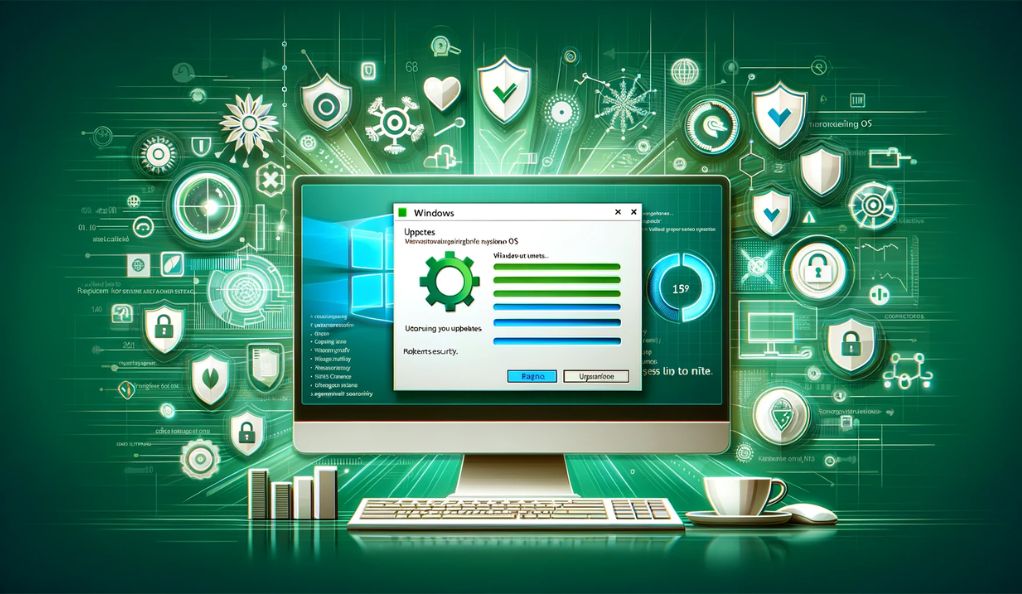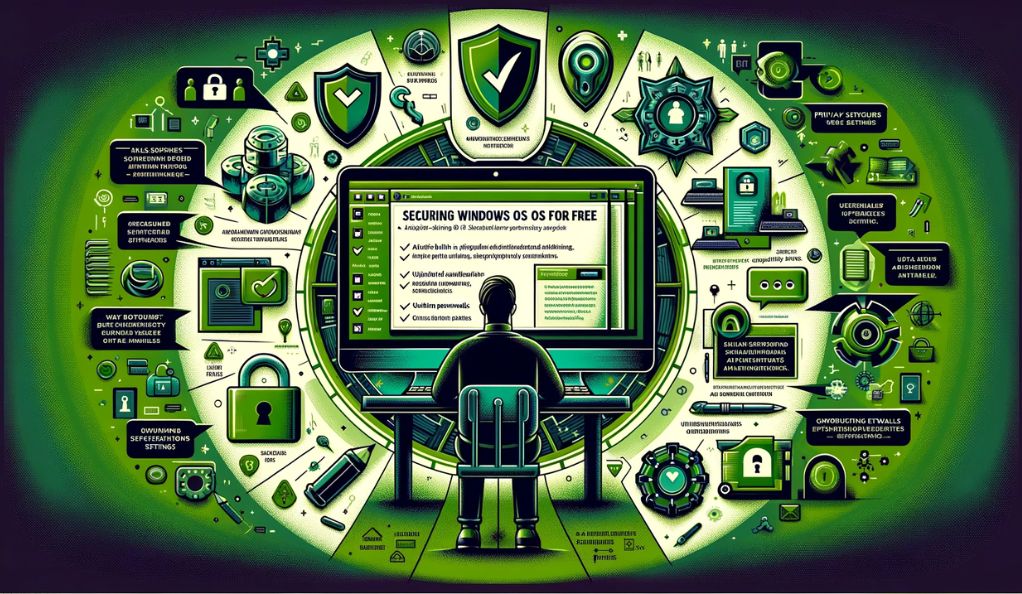Understanding Windows Security Basics
Windows operating system, widely used across the globe, is a prime target for cyber threats. Ensuring its security is not just advisable; it’s essential. This guide begins by laying the foundation of Windows security basics, empowering you to protect your system effectively.
What Is Windows Security?
Windows Security is an integrated part of the Windows OS, designed to safeguard your computer from various threats. It encompasses several features like virus and threat protection, account protection, firewall and network protection, and more. Understanding these components is the first step towards a fortified system.
The Role of Windows Security Updates
Regular security updates are vital. They patch vulnerabilities, enhance features, and provide new protections against emerging threats. Ignoring these updates leaves your system exposed. Let’s look at how these updates contribute to your system’s safety:
- Patch Vulnerabilities: Updates fix security holes that could be exploited by malware.
- Enhance Existing Security Features: Improvements are made to Windows Defender and firewall settings.
- Address New Threats: As new types of malware emerge, updates equip your system to combat them.
Setting Up Basic Security Features
Maximizing the in-built security features in Windows is your first line of defense. Here’s how to set them up effectively:
Windows Defender: Your Built-in Guard
Windows Defender, a free anti-malware component of Windows, offers real-time protection against threats. To activate and optimize it, follow these steps:
- Open the Windows Security app.
- Click on ‘Virus & threat protection’.
- Ensure Real-time protection is turned on.
Regularly check this section for updates to keep your system’s defenses sharp.
Creating a Strong Password and Utilizing Windows Hello
A strong password is crucial. It should be complex, unique, and known only to you. After setting a robust password:
- Consider using Windows Hello, a biometric authentication feature providing secure and fast access to your device using a fingerprint, facial recognition, or a PIN.
Activating the Firewall
The Windows Firewall prevents unauthorized access to your computer. Here’s how to ensure it’s working:
- Go to Windows Security.
- Select ‘Firewall & network protection’.
- Check that the firewall is on for both private and public networks.
Regularly reviewing these settings helps maintain optimal protection.
Regular System Updates

A key aspect of keeping your Windows OS secure is ensuring it is always up-to-date. This not only improves your system’s functionality but also its ability to resist cyber threats.
Automatic Updates: Keeping Your Guard Up Consistently
Setting up automatic updates is straightforward and highly recommended. Here’s how:
- Go to ‘Settings’ on your Windows device.
- Navigate to ‘Update & Security’.
- Under ‘Windows Update’, choose ‘Advanced options’.
- Enable ‘Automatic updates’.
By doing this, Windows will download and install updates as they become available, ensuring your system is always equipped with the latest security measures.
The Importance of Software Updates
It’s not just your operating system that needs to be up-to-date. Software applications on your computer should also be regularly updated. Outdated software can become a gateway for malware. Make a habit of checking for updates in your installed software, especially security-related tools like antivirus programs.
Securing Your Internet Browsing
Safe internet browsing is an essential part of protecting your Windows OS. Even with a secure system, risky online behavior can lead to vulnerabilities.
Best Practices for Safe Browsing
Here are some essential tips for safer internet use:
- Avoid clicking on suspicious links or downloading attachments from unknown sources.
- Be cautious on social media and don’t share personal information unnecessarily.
- Regularly clear your browser cookies and cache.
Enhancing Browser Security with Free Extensions
Several free browser extensions can significantly enhance your online security. Consider adding these to your browser:
- Ad Blockers: These prevent malicious ads from loading.
- Anti-Tracking Tools: These limit the ability of websites to track your online activity.
- HTTPS Everywhere: This ensures you are using the secure version of websites whenever possible.
Anti-Virus and Anti-Malware Protection
While Windows Defender provides basic protection, supplementing it with additional anti-virus and anti-malware software can enhance your security. Fortunately, there are excellent free options available.
Choosing the Right Free Anti-Virus Software
Here are some of the best free antivirus programs you can use:
- Avast Free Antivirus: Known for its effectiveness in detecting and neutralizing malware.
- AVG AntiVirus FREE: Offers protection against viruses, spyware, ransomware, and other malware.
- Bitdefender Antivirus Free Edition: Provides real-time threat detection without slowing down your PC.
How to Use These Tools Effectively
After choosing and installing an antivirus program:
- Ensure it is always updated to the latest version.
- Schedule regular full system scans to check for any hidden malware.
- Pay attention to the antivirus notifications and take recommended actions immediately.
Securing Network Connections

Your network connection is a potential entry point for cyber threats. Securing it is a crucial step in safeguarding your Windows OS.
How to Secure Your Wi-Fi Network
- Change the default username and password of your Wi-Fi router.
- Use WPA3 security for your Wi-Fi connection if available, or WPA2 as the minimum.
- Disable WPS (Wi-Fi Protected Setup) as it can be a security vulnerability.
Using a VPN for Additional Security
A VPN (Virtual Private Network) can provide an additional layer of security, especially when using public Wi-Fi networks. Here are some free VPN options:
- ProtonVPN: Offers unlimited data and a strict no-logging policy.
- Windscribe: Provides a generous data allowance and strong privacy protections.
- Hotspot Shield: Known for its fast speeds and simple interface.
Data Encryption and Backup
Protecting your sensitive data involves two key strategies: encryption and regular backups. These steps ensure your information remains confidential and is recoverable in case of a cyberattack or system failure.
Steps to Encrypt Sensitive Files and Folders
Windows provides a built-in tool for encryption called BitLocker. Here’s how to use it:
- Right-click on the drive or folder you want to encrypt.
- Choose ‘Turn on BitLocker’ and follow the setup instructions.
- Store the recovery key in a safe place.
For those without BitLocker, tools like VeraCrypt offer a free alternative for encrypting files and drives.
Free Tools for Data Encryption
- VeraCrypt: Highly regarded for creating encrypted containers and encrypting entire drives.
- AxCrypt: Offers simple, strong encryption and is user-friendly.
Guide to Regularly Backing Up Data
Regular backups are crucial for data recovery in case of loss or corruption. Windows provides an inbuilt tool for this purpose:
- Search for ‘Backup settings’ in the Windows search bar.
- Choose ‘Add a drive’ and select an external drive or network location for your backups.
- Configure your backup settings according to your preference.
Recognizing and Avoiding Phishing and Scams
Cybersecurity isn’t just about tools and settings; it’s also about being aware and vigilant. Understanding how to recognize phishing attempts and scams is crucial.
Tips for Identifying Suspicious Emails and Websites
- Look for misspellings, poor grammar, or unusual URLs.
- Be wary of emails asking for personal information or urging immediate action.
- Verify the authenticity of requests by contacting the company directly through official channels.
Steps to Take If You Suspect a Security Breach
- Immediately change your passwords.
- Run a full system scan using your antivirus software.
- Consider contacting relevant authorities if sensitive information is compromised.
Conclusion
Securing your Windows OS need not be an expensive or daunting task. By leveraging the free tools and features available within the system, along with adopting prudent cybersecurity practices, you can significantly enhance the security of your computer. From understanding the basics of Windows Security to implementing advanced measures like data encryption and avoiding phishing scams, each step contributes to building a robust defense against potential cyber threats.
Remember, security is not a one-time effort but an ongoing process. Regular updates, vigilant browsing habits, and staying informed about the latest security trends are crucial for maintaining the integrity of your system. By taking these proactive steps, you can enjoy a safer online experience, free from the worries of cyber vulnerabilities.
We hope this comprehensive guide empowers you to fortify your Windows OS effectively and without cost. Stay vigilant, stay updated, and continue to explore ways to enhance your cybersecurity posture.








